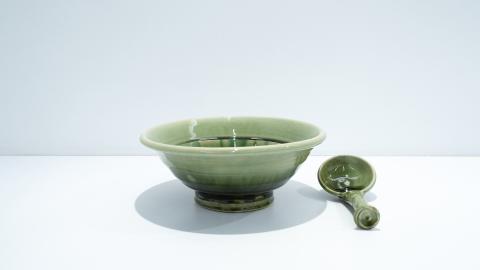
As all students who have stayed up late cramming for exams know, ramen can be just as satisfying when slurped from a Styrofoam cup as it can from a beautiful porcelain bowl. But luckily, there is a long tradition of ceramic artistry that has led to the creation of the stylish and functional bowls in which ramen is typically served across Japan, most notably in Mino, the region known as the “Ceramic Valley”. As Mino-ware is the spotlight of the current JAPAN HOUSE Los Angeles exhibition, “The Art of the Ramen Bowl”, read on to discover more about this region and its role in the ramen story.
Over 90% of the porcelain bowls commonly used for ramen in Japan are produced in Mino, an area that has developed its ceramics craftsmanship over many centuries. The region of Mino comprises several towns located in Gifu Prefecture in the central part of Honshu, known for its lush forests and natural beauty. In the region one can still see some of the triangular thatched-roof farmhouses of traditional rural Japan, as well as the rivers and valleys that left deposits of minerals and clay so ideal for the development of ceramics in this spot. Based on archaeological evidence of kilns and fragments, Mino-ware (mino-yaki) dates back to the around the 7th century.
For much of its early history, the majority of Japanese pottery was functional, such as sturdy unglazed stoneware vessels for the needs of an agrarian society, based on simple techniques of shaping and then firing clay (see also this article on the long evolution of Japanese ceramics). Over the centuries, different types of glazes, decoration, and more refired forms were developed at various kilns around the country, including the region of Seto near Mino. During the ongoing civil war and chaos of the Azuchi-Momoyama period (1568–1614), many potters from Seto fled to the area that is now Mino, bringing their secrets and skills to Mino’s stoneware ceramic production. Their arrival coincided with the rise of the tea ceremony among the military elite, and several new and unique ceramic styles (most notably Shino and Oribe ware) evolved at the kilns of Mino and found great favor among tea masters and practitioners around Japan. By the late 17th-century, a growing merchant class meant an even wider consumer base for high-quality tableware, which Mino’s kilns were able to supply in ever-inventive new technical and aesthetic approaches. In the late 19th century, the kilns began to use pure white porcelain clay and decorated their wares with patterns printed using stencils and eventually copperplate transfers, allowing for the mass production of vessels featuring complex designs. In the early 20th century, expanding electricity infrastructure allowed Mino to further scale up in its output through mechanized manufacturing.

Shino ware by Takumi Ando
Today, Mino is the source for approximately 50% of the porcelain production in Japan (not to mention 90% of ramen donburi bowls alone), but the region manages to retain a balance between mass production and the roots of craft heritage and handmade artistry. In 1978, Mino-yaki was formally recognized by Japan’s International Ministry of Trade and Industry as a traditional Japanese craft, but what is so unique about Mino-yaki is that the term doesn’t describe merely one style. Instead, it refers to over 15 types of ceramic craft, owing to the rich and varied history of the region. Some of the most prominent that are featured in the current exhibition include Oribe ware, a type of stoneware ceramic known for its whimsical shapes, underglaze iron-brown drawings beside areas of copper green or iron black glaze ; Shino ware, characterized by its thick, creamy, white feldspar glaze; and blue-and-white porcelain, pure white ceramics painted with cobalt-blue designs under a transparent glaze and then fired at high temperatures.

Oribe ware by Hiroshi Sakaguchi
The kilns and ceramics factories of Mino produce a large variety of functional tablewares for markets across the country. In addition, many ceramic artists on a smaller scale in individual studios blending tradition with experimentation to create art objects that are shown in museums, galleries, and festivals worldwide. Mino itself is home to the “International Ceramics Festival”, a triennial event that celebrates this craft and draws ceramics artisans from far and wide (the next will take place in 2024). The festival’s logo evokes the two elements of “clay and flame” that are of course the roots of all ceramics – the long-ago act of profound transformation that is one of the earliest human technologies.
In an overwhelmingly digital era, the artistry and reach of Mino-yaki serves as a reminder of the power of the human hand in shaping a craft tradition. Each time we gratefully cradle a bowl of simple ramen between our hands, we become connected to the generations of ceramic artists who have worked hard to ensure that function and beauty go hand in hand.
As part of The Art of the Ramen Bowl exhibition and related programs, JAPAN HOUSE Los Angeles is proud to launch not only a Ramen Discoveries pop-up dining experience in the Level 5 restaurant space, but also a pop-up shop featuring handmade Mino-ware bowls created by Japanese artists for purchase – the ideal chance to have a piece of Mino history for your very own kitchen. See link for further details.

